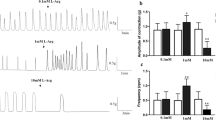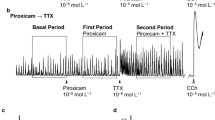Abstract
PURPOSE: This study was designed to investigate the role of nitric oxide in neurogenic relaxation of the longitudinal layer of human rectal smooth muscle. METHODS: Tissue was obtained from the mid rectum of patients undergoing anterior resection for carcinoma. Adjacent strips of longitudinal muscle were dissected and mounted in organ baths for isometric tension recording. In preliminary experiments to determine the response of strips to cholinergic, adrenergic, and potential excitatory agonists, strips were superfused with standard Krebs solution (37±0.5°C; pH, 7.4±0.05). Investigation of inhibitory, nonadrenergic noncholinergic responses required the addition of 3×10−6 M histamine to induce reproducible and stable tension for five-minute “test” periods, during which electrical field stimulation (EFS) and additional drugs were applied. In these experiments, strips were superfused with Krebs solution that contained atropine sulfate (3×10−6 M) and guanethidine (3×10−6 M). RESULTS: The response to cholinergic and adrenergic agonists was typical of nonsphincter specialized gastrointestinal smooth muscle. EFS elicited frequency-dependent, neurogenic (tetrodotoxin-sensitive) relaxations of precontracted strips, which were reduced in dose-dependent fashion by addition ofNω-nitro-l-arginine and restored by addition of 3×10 −4 M l-arginine but not by d-arginine. Addition of exogenous nitric oxide (sodium nitroprusside) mimicked the relaxant response induced by EFS. CONCLUSION: Smooth muscle from the longitudinal layer of human rectum receives an intrinsic inhibitory innervation mediated by nitric oxide.
Similar content being viewed by others
References
Arhan P, Faverdin C, Persoz B,et al. Relationship between viscoelastic properties of the rectum and anal pressure in man. J Appl Physiol 1976;41:677–82.
D'Amato M, Curro D, Montuschi P. Effects of nitric oxide synthase inhibitors on the relaxation induced by non-adrenergic non-cholinergic nerve-stimulation in the rat gastric fundus. Pharmacol Res 1992;1:1–2.
Desai KM, Sessa WC, Vane JR. Involvement of nitric oxide in the reflex relaxation of the stomach to accommodate food or fluid. Nature 1991;351:477–9.
Kamata K, Kohzuki M, Misawa M, Kasuya Y. Involvement of nitric oxide pathway in non-adrenergic noncholinergic (NANC) relaxation in the rat stomach: differential innervation of NANC nerves in the longitudinal and circular muscle of the fundus. Gen Pharmacol 1993;24:1403–10.
Stebbing JF, Brading AF, Mortensen NJ. Nitrergic innervation and relaxant response of rectal circular smooth muscle. Dis Colon Rectum 1996;39:294–9.
Maggi CA, Barbanti G, Turini D, Giuliani S. Effect of N-monomethyl L-arginine (L-NMMA) and N-nitro Larginine (L-NOARG) on non-adrenergic noncholinergic relaxation in the circular smooth muscle of the human ileum. Br J Pharmacol 1991;103:1970–2.
Moore PK, al-Swayeh OA, Chong NW, Evans RA, Gibson A. L-NG-nitro arginine (L-NOARG), a novel, Larginine reversible inhibitor of endothelium-dependent vasodilatationin vitro. Br J Pharmacol 1990;99:408–12.
Feelisch M, Noack EA. Correlation between NO formation during degradation of organic nitrates and activation of guanylate cyclase. Eur J Pharmacol 1987;139:19–30.
Glavind EB, Forman A, Madsen G, Svane D, Andersson KE, Tottrup A. Mechanical properties of isolated smooth muscle from human rectum and internal anal sphincter. Am J Physiol 1993;265:G792–8.
O'Kelly TJ, Brading A, Mortensen NJ.In vitro response of the human anal canal longitudinal muscle layer to cholinergic and adrenergic stimulation: evidence of sphincter specialisation. Br J Surg 1993;80:1337–41.
Tam FS, Hillier K. The role of nitric oxide in mediating non-adrenergic non-cholinergic relaxation in longitudinal muscle of human taenia coli. Life Sci 1992;51:1277–84.
Furness JB, Costa M. Sympathetic influences on gastrointestinal function. In: Furness JB, Costa M, eds. The enteric nervous system. Edinburgh: Churchill Livingstone, 1987:207–38.
Author information
Authors and Affiliations
Additional information
Supported and financed by the Medical Research Council, United Kingdom.
John Stebbing is in receipt of a Medical Research Council Clinical Training Fellowship.
Read at the meeting of The American Society of Colon and Rectal Surgeons, Seattle, Washington, June 9 to 14, 1996.
About this article
Cite this article
Stebbing, J.F., Brading, A.F. & Mortensen, N.J.M. Role of nitric oxide in relaxation of the longitudinal layer of rectal smooth muscle. Dis Colon Rectum 40, 706–710 (1997). https://doi.org/10.1007/BF02140901
Issue Date:
DOI: https://doi.org/10.1007/BF02140901




